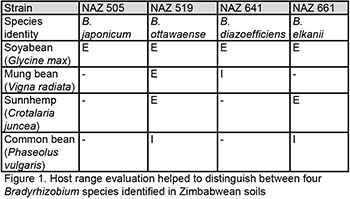Rhizobia inoculants form the backbone of soyabean production, which is important in Zimbabwe’s agriculture led economy. Traditionally, soyabean production is carried out with the use of elite, but exotic, rhizobia inoculant strains. It has been established in previous studies (Zengeni et al., 2003; Zengeni et al., 2006) that these strains do not persist well in the fields, and require frequent inoculation.
Poor rhizobia survival is due to low levels of clay, organic carbon and soil fertility. In my study, I was prospecting for indigenous strains as we hypothesised that they are adapted to the Zimbabwean agro-climatic conditions and therefore persist. The first aim was to find strains that are comparable to the exotic strains with respect to nitrogen fixation capacity. I isolated a total of 137 authenticated soyabean nodulating isolates from contrasting agro-climatic and management conditions. I compared them for nitrogen fixation against each other under glasshouse conditions at Murdoch University, Australia. I identified strains that are efficient in nitrogen fixation and could replace the exotic inoculant strains in future.
Secondly, I examined the diversity of the indigenous soyabean nodulating rhizobia population in Zimbabwe, using molecular methods as well as standard comparisons on culture media on the isolates obtained in the study (see Podcaster 32). Culture morphology generated two major groups with subgroups within, while molecular characterizations revealed four Bradyrhizobium species.
| Another study in 2015 was carried out to develop a method to identify the rhizobia strains. Evaluation of host range across a specific range of legume hosts provided some insight into species identity (Figure 1). Additionally, I developed a rapid molecular method to identify strains as part of quality assurance and control during inoculant production. |  |
All this experimental work was carried out at Murdoch University between 2012 and 2015, after which I returned to work at the Soil Productivity Research Laboratory in Zimbabwe. I continue writing my thesis and look forward to submitting it and using the new elite indigenous rhizobia from my study for soyabean production in Zimbabwe.
Mazvita Chiduwa, Murdoch University, Australia
References:
Zengeni, R., Mpepereki, S. and Giller, K.E. (2003). Survival and persistence of introduced commercial rhizobial inoculant strains in selected smallholder field environments of Zimbabwe. Grain Legumes and Green Manures for Soil Fertility in Southern Africa: Taking Stock of Progress, SoilFertNet and CIMMYT-Zimbabwe, Harare, Zimbabwe, pp. 53-56.
Zengeni, R., Mpepereki, S. and Giller, K.E. (2006). Manure and soil properties affect survival and persistence of soyabean nodulating rhizobia in smallholder soils of Zimbabwe. Applied Soil Ecology, 32, pp. 232-242.
